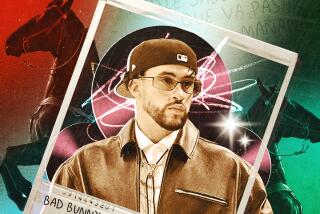Review: Richard Diebenkorn show at Pepperdine zeroes in on experimental early years
The exhibition “Richard Diebenkorn: Beginnings, 1942-1955” does a good job busting up a pretty entrenched assumption.
A standard timeline of the artist, one of California’s most important painters, has him launching headlong into Abstract Expressionist waters (when he lived in New Mexico), pulling back to representational landscapes and figures in interiors (in the Bay Area), then returning to full abstraction with ethereal veils of structured color in the great “Ocean Park” paintings (in Los Angeles). But the narrative is not that simple.
At the Frederick R. Weisman Museum of Art at Pepperdine University, a handsome traveling exhibition organized by Sacramento’s Crocker Art Museum in conjunction with the Richard Diebenkorn Foundation zeroes in on his early years. Before there was Ab Ex, it handily demonstrates — and for a while afterward too — he was all over the map.
Which is to be expected. Diebenkorn was feeling his way through.
Diebenkorn was 23 when his Marine Corps service ended along with World War II. By the time he settled in Albuquerque five years later, in 1950, he had a wife and two kids, and the family had crisscrossed the country, living in San Francisco, Woodstock, N.Y., and Sausalito. He finished a degree from Stanford, where the war had interrupted his studies, and he was picking up visual information all along the way.
SPRING ARTS: Exhibitions on our radar »
REVIEW: Charles White show at LACMA pinpoints the power of an underappreciated black artist »
The show, drawn from the foundation’s collection and most never exhibited before, has been trimmed to about 75 works (from 100). Only a handful are paintings, many of them rather worse for wear. But the abundance of works on paper makes it well worth seeing, since drawings are where Diebenkorn trained his hand and worked out his pictorial ideas.
Here he’s applying Cubist facture to a landscape, there he’s adding a blast of Matisse’s color, in between he’s rendering a more conventional study of the figure or a still life; veils of liquid hue are perhaps inspired by a new interest in the nature abstractions of Arshile Gorky. The paintings, even in their mostly less than pristine state, do show these and other elements working their way into his canvases.
Among the most intriguing is an animated 1954 oil sketch of a horse and rider galloping across the small canvas, with three brushy bands of color behind them. Yes, Diebenkorn would likely have witnessed similar action firsthand in rural New Mexico. But, if the image puts you in mind of Rembrandt’s famously enigmatic “Polish Rider” painting in New York’s Frick Collection, that makes sense too.
Frederick R. Weisman Museum of Art, Pepperdine University, 24255 Pacific Coast Highway, Malibu. Through March 31. (310) 506-4851, arts.pepperdine.edu
REVIEW: Allen Ruppersberg show at the Hammer Museum is a don’t-miss tour de force »
More to Read
The biggest entertainment stories
Get our big stories about Hollywood, film, television, music, arts, culture and more right in your inbox as soon as they publish.
You may occasionally receive promotional content from the Los Angeles Times.







